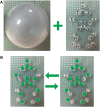A Light Spot Humanoid Motion Paradigm Modulated by the Change of Brightness to Recognize the Stride Motion Frequency
- PMID: 30374295
- PMCID: PMC6196316
- DOI: 10.3389/fnhum.2018.00377
A Light Spot Humanoid Motion Paradigm Modulated by the Change of Brightness to Recognize the Stride Motion Frequency
Abstract
The steady-state visual evoked potential (SSVEP)-based brain-computer interface (BCI) usually has the advantages of high information transfer rate (ITR) and no need for training. However, low frequencies, such as the human stride motion frequency, cannot easily induce SSVEP. To solve this problem, a light spot humanoid motion paradigm modulated by the change of brightness was designed in this study. The characteristics of the brain response to the motion paradigm modulated by the change of brightness were analyzed for the first time. The results showed that the designed paradigm could induce not only the high flicker frequency but also the modulation frequencies between the change of brightness and the motion in the primary visual cortex. Thus, the stride motion frequency can be recognized through the modulation frequencies by using the designed paradigm. Also, in an online experiment, this paradigm was employed to control a lower limb robot to achieve same frequency stimulation, which meant that the visual stimulation frequency was the same as the motion frequency of the robot. Also, canonical correlation analysis (CCA) was used to distinguish three different stride motion frequencies. The average accuracies of the classification in three walking speeds using the designed paradigm with the same and different high frequencies reached 87 and 95% respectively. Furthermore, the angles of the knee joint of the robot were obtained to demonstrate the feasibility of the electroencephalograph (EEG)-driven robot with same stimulation.
Keywords: brain–computer interface; motion modulated by the change of brightness; same frequency stimulation; steady-state visual evoked potential; stride motion frequency.
Figures







Similar articles
-
High-Frequency SSVEP Stimulation Paradigm Based On Dual Frequency Modulation.Annu Int Conf IEEE Eng Med Biol Soc. 2019 Jul;2019:6184-6187. doi: 10.1109/EMBC.2019.8856903. Annu Int Conf IEEE Eng Med Biol Soc. 2019. PMID: 31947255
-
Effects of fatigue on steady state motion visual evoked potentials: Optimised stimulus parameters for a zoom motion-based brain-computer interface.Comput Methods Programs Biomed. 2020 Nov;196:105650. doi: 10.1016/j.cmpb.2020.105650. Epub 2020 Jul 9. Comput Methods Programs Biomed. 2020. PMID: 32682092
-
A Radial Zoom Motion-Based Paradigm for Steady State Motion Visual Evoked Potentials.Front Hum Neurosci. 2019 Apr 16;13:127. doi: 10.3389/fnhum.2019.00127. eCollection 2019. Front Hum Neurosci. 2019. PMID: 31040775 Free PMC article.
-
Highly Interactive Brain-Computer Interface Based on Flicker-Free Steady-State Motion Visual Evoked Potential.Sci Rep. 2018 Apr 11;8(1):5835. doi: 10.1038/s41598-018-24008-8. Sci Rep. 2018. PMID: 29643430 Free PMC article.
-
An amplitude-modulated visual stimulation for reducing eye fatigue in SSVEP-based brain-computer interfaces.Clin Neurophysiol. 2014 Jul;125(7):1380-91. doi: 10.1016/j.clinph.2013.11.016. Epub 2013 Dec 1. Clin Neurophysiol. 2014. PMID: 24368034 Clinical Trial.
Cited by
-
Enhancing Detection of SSMVEP Induced by Action Observation Stimuli Based on Task-Related Component Analysis.Sensors (Basel). 2021 Aug 4;21(16):5269. doi: 10.3390/s21165269. Sensors (Basel). 2021. PMID: 34450713 Free PMC article.
References
-
- Alhaddad M. J. (2012). Common average reference (CAR) improves P300 speller. Inter. J. Eng. Technol. 2:31.
-
- Diez P. F., Mut V. A., Laciar E., Perona E. M. A. (2014). Mobile robot navigation with a self-paced brain-computer interface based on high-frequency SSVEP. Robotica 32 695–709. 10.1017/S0263574713001021 - DOI
LinkOut - more resources
Full Text Sources

